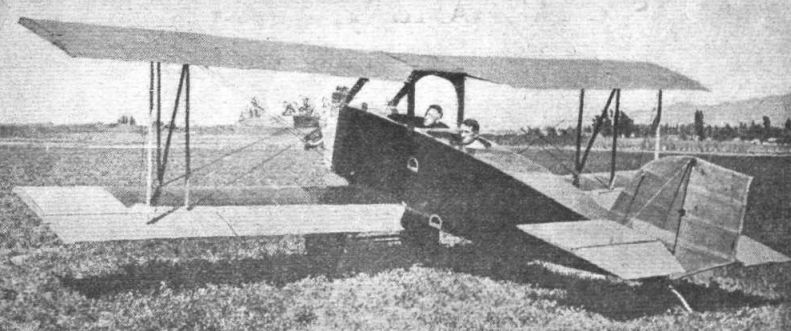
Flight, December 1923
THE KINNER "AIRSTER" SPORTPLANE
WHILST the "Jennie," or Curtiss J.N. type, has given considerable satisfaction to numerous owner-pilots and aerosportsmen in the U.S.A., there has been of late a growing demand for a more up-to-date type of machine, with improved performance, suitable for the same class of work. As may be evinced from the descriptions of such machines, built in the U.S.A., which have appeared from time to time in these pages, this demand has not remained uncatered for, and we give below - through the courtesy of our Californian contemporary The Ace - a brief description of another of these low-powered machines.
The machine in question is known as the Kinner "Airster," and was designed and built by the Kinner Airplane and Motor Corporation, of Glendale,. Cal., who have concentrated on this type of machine since 1920. This latest model made its first public appearance at the opening of the Glendale Municipal Airport, on March 17 last, and was flown by W. B. Kinner, president of the company.
The fuselage of the "Airster" is almost entirely of wooden construction. The sides, top, and bottom are 3/32-in. three-ply mahogany. Only two bulkheads are used, one fore and one aft of the cockpits. All the rest of the longitudinal and transverse bracing is accomplished with spruce members, 1/2 in. by 3/4 in. cross section. The cockpits are arranged in tandem, with dual control. There is ample room for the comfort of both occupants, a feature that is often more or less neglected in the smaller 'planes of this type.
All the essential parts of the machine are very accessible, and it is possible to remove the petrol tank in 15 minutes. The centre section struts are of the inverted U-type, built up of five-ply spruce. This type of strut gives both pilot and passenger excellent vision due to the elimination of cross wires.
The wing cellule is single bay, and the interplane struts are of the N-type, of welded streamline tubing. All exposed wiring is the solid streamline pattern. The feature of interchangeability has been very well carried out in this machine. The upper and lower wings are identical, whilst all the ailerons are the same, as well as the three tail group members, the two elevators and the rudder.
The landing gear is of the conventional V-type, with each pair of struts joined through its five-ply construction. The wheels are 26 ins. by 3 ins., and a spring leaf is used for the tail skid. A streamlined handle is fastened to the top of the skid to facilitate handling the tail when taking the machine in and out of the hangar. A 60 h.p. three-cylindered, air-cooled "Kinner" engine is mounted in the nose of the fuselage.
The principal characteristics of the “Airster" are :-
Span 26 ft. 3 ins.
O.A.length 19 ft. 6 ins.
Height 7 ft. 6 ins.
Gap 4 ft. 6 ins.
Chord 4 ft. 0 ins.
Stagger 9 ins.
Decalage 1/2 deg.
Dihedral 2 deg.
Wing area 200 sq. ft.
Wing curve R.A.F. 6.
Weight empty 550 lbs.
Weight loaded 1,000 lbs.
Weight/h.p. 16-7 lbs.
Weight/sq. ft. 5 lbs.
Speed range 30-90 m.p h.
Climb (ground) 1,000 ft./min.
Ceiling 13,000 ft.
Range 350 miles.
- Flight, December 1923
THE KINNER "AIRSTER" SPORTPLANE
Фотографии
-
Flight 1923-12 / Flight
THE KINNER "AIRSTER" SPORTPLANE: Three-quarter rear view.
-
Авиация и Время 2005-04 / А.Мандель - Первая леди Атлантики /Портреты/
"Киннер Эйрстер" - первый собственный самолет Амелии Эрхарт
-
Flight 1923-12 / Flight
THE KINNER "AIRSTER" SPORTPLANE: Two views showing, above, a three-quarter front view, and, below, the fuselage.
- Фотографии


